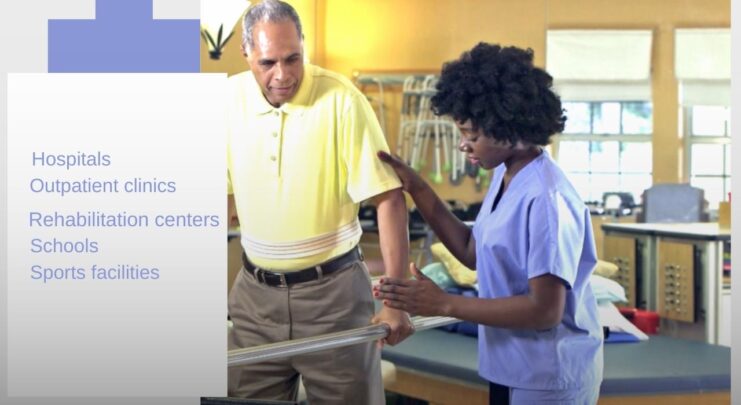Physical therapy is a vital healthcare profession dedicated to enhancing individuals’ physical function and mobility, ultimately improving their quality of life. To embark on a career as a licensed and practicing physical therapist, one must meet specific educational prerequisites and attain the necessary credentials.
Foundational Education (Bachelor’s Degree)

The initial step towards becoming a physical therapist involves completing a bachelor’s degree program. While there isn’t a rigid requirement for the specific major, most applicants choose fields like biology, kinesiology, exercise science, or related healthcare disciplines.
During their undergraduate studies, students should focus on completing prerequisite courses necessary for admission to physical therapy graduate programs. Visit comphealth.com to learn more.
- Anatomy and Physiology: A profound understanding of human anatomy and bodily functions forms the bedrock of a successful career in physical therapy.
- Biology and Chemistry: Proficiency in these sciences is critical for comprehending the physiological processes that underpin injury and recovery.
- Physics: Physics coursework aids in comprehending movement principles and biomechanics, essential aspects of physical therapy.
- Psychology: An appreciation of psychology proves valuable when interacting with patients, addressing their emotional needs, and considering psychological factors in their rehabilitation.
- Statistics: A grasp of statistics is beneficial for conducting research and evaluating treatment outcomes, essential aspects of modern physical therapy practice.
Doctor of Physical Therapy (DPT) Program

The principal educational requirement for becoming a licensed physical therapist is the successful completion of a Doctor of Physical Therapy (DPT) program. Typically spanning three years, DPT programs aim to provide students with a comprehensive education in physical therapy theory, practice, and clinical applications.
- Curriculum: DPT programs combine classroom-based coursework with practical clinical training.
- Clinical Experience: DPT programs feature clinical rotations that expose students to real-world scenarios. Under the supervision of licensed physical therapists, students gain hands-on experience in diverse healthcare settings, including hospitals, outpatient clinics, and rehabilitation centers.
- Research Component: Some DPT programs incorporate research components, wherein students engage in scholarly activities, contributing to the advancement of the field.
- Specialization Options: While not mandatory, certain DPT programs offer specialized tracks or elective courses, allowing students to concentrate on areas like pediatric physical therapy, sports rehabilitation, or orthopedics.
Admission Requirements for DPT Programs
Admission to DPT programs is competitive, necessitating that aspiring physical therapists fulfill specific criteria for consideration. While prerequisites may vary between programs, common admission requirements and criteria encompass the following.
- Bachelor’s Degree: Applicants usually must hold a bachelor’s degree from an accredited institution.
- Minimum GPA: Many DPT programs stipulate a minimum undergraduate GPA for eligibility. This threshold may vary but typically hovers around 3.0 or higher on a 4.0 scale.
- Graduate Record Examination (GRE): GRE scores are often a part of the application process. Applicants should acquaint themselves with the specific GRE requirements of their intended programs.
- Letters of Recommendation: Applicants generally need to provide letters of recommendation from professors, healthcare professionals, or individuals who can vouch for their qualifications and readiness for the program.
- Observation Hours: Completion of a specified number of observation hours under the guidance of a licensed physical therapist is a common requirement. These hours offer valuable exposure to the profession and demonstrate genuine interest.
- Personal Statement: The submission of a well-crafted personal statement or essay that elucidates the applicant’s motivations, objectives, and suitability for the program is frequently necessary.
- Interviews: Some programs may invite applicants for interviews to evaluate their interpersonal skills, communication capabilities, and professionalism.
- Prerequisite Coursework: Applicants are typically mandated to have finished prerequisite courses in subjects like anatomy, physiology, biology, chemistry, physics, and psychology, meeting specific grade requirements.
Obtaining State Licensure
After successfully concluding a DPT program, graduates must secure state licensure to practice as physical therapists. Requirements for licensure are contingent on the state but often encompass passing the National Physical Therapy Examination (NPTE). Eligibility for the NPTE usually necessitates the completion of an accredited DPT program.
Continuing Education and Specialization (Optional)
Physical therapists have the option to pursue further education and specialization to focus on specific facets of their practice. Continuing education courses, certifications, and advanced clinical training programs are available in diverse areas, such as the following.
- Orthopedics: Specialization in orthopedic physical therapy involves advanced training in musculoskeletal conditions and treatment techniques.
- Neurology: Neurological physical therapists specialize in working with individuals dealing with conditions like stroke, spinal cord injuries, and Parkinson’s disease.
- Pediatrics: Pediatric physical therapists focus on addressing developmental delays and physical disabilities in children.
- Sports Rehabilitation: This specialization involves working with athletes to prevent and treat sports-related injuries.
- Geriatrics: Geriatric physical therapists concentrate on the distinct needs of elderly individuals, including fall prevention and managing age-related conditions.
- Cardiovascular and Pulmonary Rehabilitation: Therapists specializing in this area work with patients recuperating from heart and lung conditions.
Continuing Education Requirements
Physical therapists often have to complete continuing education credits to maintain their licensure. This requirement ensures that practitioners stay up-to-date with the latest advancements in the field, sustaining their competence.
Professional Association Membership
Many physical therapists opt to join professional organizations like the American Physical Therapy Association (APTA). These associations provide resources, networking opportunities, and support for professional development, enabling practitioners to stay connected with their peers and remain informed about industry developments.
Career Exploration

Physical therapists can work across various healthcare settings, including hospitals, outpatient clinics, rehabilitation centers, schools, and sports facilities. They can also opt to specialize in specific areas, such as sports medicine, women’s health, or wound care, based on their interests and aptitudes.
Advanced Degrees
Certain physical therapists choose to pursue advanced degrees, such as a Master of Business Administration (MBA) or a Doctor of Philosophy (Ph.D.). These degrees can broaden career opportunities, enabling practitioners to delve into research, teaching, or healthcare administration roles.
Attaining licensure and pursuing a career as a physical therapist involves a structured educational journey. This comprehensive preparation equips physical therapists to make a substantial and positive impact on patients’ lives by facilitating the restoration and maintenance of their physical functionality and mobility. The profession not only offers a fulfilling career but also various opportunities for growth and specialization across diverse healthcare settings.

